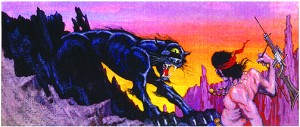The last few weeks I’ve been spending hours and hours listing our art books on eBay. A once pretty vast assortment which now – owing to our recent move to much smaller digs – needs to be permanently and with much regret, “pruned” to apartment-sized proportions.

Among the recent candidates for sale I yesterday unearthed an old favorite of mine: The New Visions A Collection Of Modern Science Fiction Art with introduction by Frederik Pohl (Doubleday, 1982) It represented an interesting concept at the time, and the book’s now fraying cover is testament to its value to me over the years. Which is why I am devoting this post to it.
With apologies for the cliche’, this was a real ‘eye-opener’ when I first picked it up. Because by that point – some time in the late 80s, as I recall – Howard (spouse) and I were already way deep into the field of sf/f art collecting – growing what was to become, unplanned – one of the largest private collections of such art. So it was really important to me to keep up with the names of “rising artists”.
This book not only featured the artists who were commissioned to produce art for Doubleday’s hugely successful (ok, ubiquitous) Science Fiction Book Club (we were subscribers ourselves for years, like just about everyone) It also was a (by that time) more or less established marketing ploy, used by several publishers to advertise their lines of SF/F books.

“New Visions” was published to advertise Doubleday’s Book Club – but it had much more than gimmickry going for it. By the late 1970s books featuring commercial artists’ science fictional works was already a popular strategy used by U.S. as well as UK publishers. In the UK these were sometimes based on rather spurious “invented” premises which were were highly entertaining, though they served the aims of agents/agencies who represented the artists (as example, agent John Spencer, and the popular TTA – Terran Trade Authority – Handbooks published by Hamlyn, UK). But whatever their raison d’etre, like canaries in a coal mine they persuaded readers that the air art in SF-land was safe to breathe love.
The proliferation of such books in effect paved the way for acknowledging that sf/f pulp, magazine and book art was not only historically and culturally important, but worthy of collecting. The downside? Not all artists in these were to fare equally well in their careers . . . despite Doubleday’s fanfare, some of their artists, as it turned out, failed to launch.
You’d think that anyone who was chosen for inclusion in “New Visions” (or any book like it) would be a most excellent candidate for “collectability” two to three decades later. Alas, that was not the case.
Here’s the list, in alpha order, of the artists featured in “New Visions” (these appeared, in this order, on the back cover):
Ken Barr
John Berkey
Richard Corben
Tony Fiyalko
Frank Frazetta
Tony Gleeson
Mike Hinge
Les Katz
Larry Kresek
Don Maitz
Estaban Maroto
Carlos Ochagavia
Richard Powers
Martin Rigo
David K. Stone
Ed Valigursky
Victor Valla
Boris Vallejo
Gary Viskupic
Michael Whelan
Jack Woolhiser
James Z. Yost

Can you describe the work of Martin Rigo? Les Katz? James Z. Yost? No? Hmmm. How about Jack Woolhiser (above), Gary Viskupic (here) or Victor Valla, Tony Glleson, Mike Hinge and Ken Barr (below)?
NOT ONLY were half of the 22 artists listed unknown to me, when I first read the list, but to my dismay, when I returned to this grouping years later, as I ultimately did when doing research for my “Science Fiction and Fantasy Artists of the Twentieth Century: A Biographical Dictionary” (McFarland, 2009), I was only a smidgen more enlightened. Some of these artists were not just no longer around, they were simply not known. Not to me, and not (I would bet) 100% of the dozens of active collectors I was dealing with.
While several of these artists were already well-established in the genre at the time of the book’s writing (e.g., Ed Valigursky, Richard Powers, Frank Frazetta – the latter chosen to lead off the book, despite being 5th, alphabetically), and others subsequently garnered widespread and notable acclaim – AND I THINK YOU WILL BE ABLE TO PICK THOSE NAMES OUT WITHOUT MY HELP – a regrettable number did not rise to memorability. Their names were largely forgotten, the promise of “new visions” fading within a decade . . . their art untraded/in very low demand (Translation: of little value). Some of these artists, to be sure, didn’t stick around long enough to have a real stake in the industry (James Z Yost, for example). Others, however, stuck around for years and years. But consistently flew below fans’ and collectors’ radar.
Why was this? Was it merely the luck of the draw, that the commercial assignments they got rendered them invisible to readers (and then collectors) of SF/F? Was there something about their art that made them forgettable? The late 70s/early 80s after all was the time when massive artistic talent was being drawn to the field. The exploding popularity of this literary market – paying high rates – attracted fine artists, as well as hugely talented and skilled commercial artists. What if someone came along and “discovered” them, and made their art accessible, would they suddenly receive the recognition, the status, that others had been getting all along – simply by virtue of their visibility?

When I started up Worlds of Wonder, 1991, it was to bring exposure to the art, and the artists…to make their art “accessible” to collectors. For some artists that was easy. I didn’t have to spend much time explaining who they were and what they had done. At the same time, whenever I could, I would seek out artists whose career trajectories – however successful – had not made room for the possibility, if not the probability, of sales of their original works.
Ken Barr, John Berkey, Mike Hinge, Tony Gleeson, Don Maitz, Richard Powers, Victor Valla, Michael Whelan – just to pick artists drawn from Doubleday’s list – are artists whom I have represented. By 1991 some of them needed no introduction to collectors; they had previously won awards in the field (Hugo, Chesley) or at the least, had displayed and sold their work at conventions. But then there were the artists who did neither, and whom I took on in the hopes of making their names known, their work visible – and thence, potentially, valuable. If people saw their art, were given the opportunity to buy it, would they rise to become real blips on collectors’ radar screens?

The short answer: NO. Try as I might to inform, educate, expose, advertise, sell, you name it, some of these artists (AND AGAIN, I THINK YOU WILL BE ABLE TO IDENTIFY WHICH ONES, WITHOUT ME :)) they simply failed to launch. YES, this partially (I’d like to think, largely) can be blamed on trends in collecting, generational differences, the evolution of the field…factors which worked to popularize color over black-and-white (hindering sales of art for Gleeson), published vs. unpublished, and certainly in-genre SF/F over gothics, romance, horror, action/adventure, military art, or even advertising with imaginative themes (penalizing Barr, Hinge, Valla). YES, having a depth and width of inventory certainly helped when it came to highly prolific artists such as Berkey and Powers. There was something for everyone.
BUT. BUT. Clearly, there are variables here that go beyond . . . . How do I explain how I could sell dozens of published originals for Ken Barr, for instance – his entire inventory, actually, before he left the U.S. to retire back in his native Scotland – and yet barely get to $1000. for any of them? At a time when I could get double that for Berkey (with the same dozens sold)? I could say, euphemistically, that his work was “undervalued”. But the real point here is that no one would have had the chance to own his art AT ALL if it weren’t for his presence in “New Visions,” and me consequently asking him if he was interested in selling his art, and dozens of you ultimately owning and displaying it. Let’s agree for a moment that it doesn’t really matter whether someone would sooner pay $13,000 for a Whelan than $1300 for a Barr, today (and I say this as an owner of Ken Barr’s work, including one coming up in October.) Isn’t our little corner of the universe better for having been exposed to Doubleday’s “New Visions” and ultimately, as a consequence – – all that art being out there, enjoyed, and not languishing, forgotten entirely, in some attic somewhere?
In my dreamworld none of these artists are forgotten. It’s why I started doing blogs last year with the title “Where are they now?”
But now for the really rotten news:
AT LEAST in the 1980s – 1990s, there were publishers willing and able to support the SF/F genre with colorful books filled with genre art (in no special order: Dragon’s World/Paper Tiger, Doubleday, Rizzoli, Donning, Abrams, Pomegranate, Ballantine/Bantam, Viking, Quarto, Underwood Miller and many many more smaller presses. I challenge you to find their equivalent today, in either number of publishers or volume of published works, whether commemorating or advertising, the work of digital artists.
What do we have? With the greatest reach: SPECTRUM: The Best in Contemporary Fantasy Art. Still going strong after 20 years. . . . but beyond that???

Try Amazon.com, try hunting for art “collections” or whatever…either solo compendiums or anthologies. It’s basically dead out there except for digital art “how-tos” abd workshops. With a high proportion all e-books, kindle….not paper/print. And is it any wonder? With no stake in pushing “print” – with the associated costs for commissioning painted covers – there’s no motivation for giving a push to the artists; no cause for advertising them that way and therefore no exposure for visual artists, no “lists” of rising talents, no documentation of their output at all, apart from the brief time their book remains in print or is advertised on a website. As a believer in tangible artifacts of culture, this kind of economically driven ephemerability is yet another reason for my negativity/antipathy toward digital art.
How has the field reacted to this new landscape? Instead of companies, individuals are fighting back, stepping up to fill in the gap. In desperation, and unsupported by WotC or Hasbro, 40 artists joined together in a kickstarter project starting 2012 to publish works relating to Magic: The Gathering (https://www.fullsteampress.com/the-gathering.html). Brothers Malcolm and Michael C. Phifer privately commissioned “127 top artists of illustration, comics, fantasy, science fiction and gaming” for their self-published compendium “Lands and Legends” (2014). Such publishers as Vanguard, Titan, Underwood (publishing Spectrum and much more), Donald M. Grant, Ballistic (all digital: Expose, Exotique) are still out there. But compared to the end of the 20th century, it’s a pretty barren landscape.











